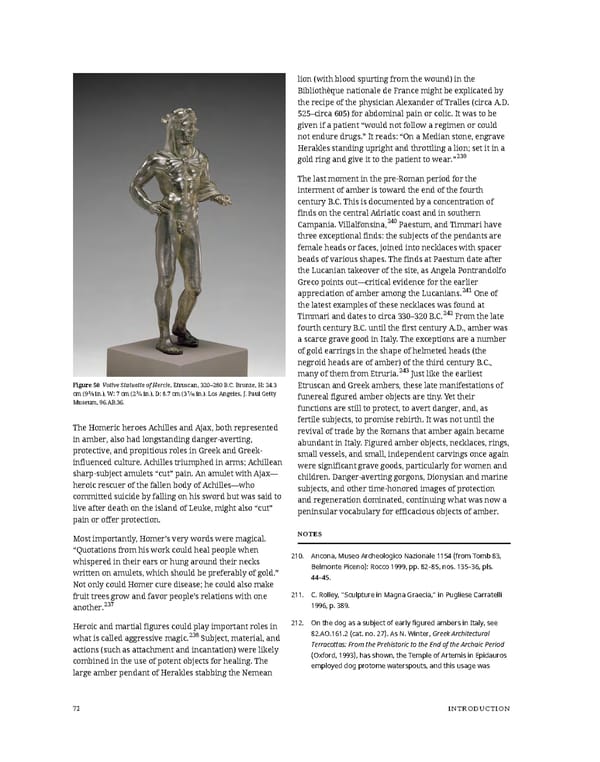lion (with blood spurting from the wound) in the Bibliothèque nationale de France might be explicated by the recipe of the physician Alexander of Tralles (circa A.D. 525–circa 605) for abdominal pain or colic. It was to be given if a patient “would not follow a regimen or could not endure drugs.” It reads: “On a Median stone, engrave Herakles standing upright and throttling a lion; set it in a gold ring and give it to the patient to wear.”239 The last moment in the pre-Roman period for the interment of amber is toward the end of the fourth century B.C. This is documented by a concentration of finds on the central Adriatic coast and in southern Campania. Villalfonsina,240 Paestum, and Timmari have three exceptional finds: the subjects of the pendants are female heads or faces, joined into necklaces with spacer beads of various shapes. The finds at Paestum date after the Lucanian takeover of the site, as Angela Pontrandolfo Greco points out—critical evidence for the earlier appreciation of amber among the Lucanians.241 One of the latest examples of these necklaces was found at Timmari and dates to circa 330–320 B.C.242 From the late fourth century B.C. until the first century A.D., amber was a scarce grave good in Italy. The exceptions are a number of gold earrings in the shape of helmeted heads (the negroid heads are of amber) of the third century B.C., many of them from Etruria.243 Just like the earliest Figure 50 Votive Statuette of Hercle, Etruscan, 320–280 B.C. Bronze, H: 24.3 Etruscan and Greek ambers, these late manifestations of cm (95⁄8 in.), W: 7 cm (23⁄4 in.), D: 8.7 cm (37⁄16 in.). Los Angeles, J. Paul Getty funereal figured amber objects are tiny. Yet their Museum,96.AB.36. functions are still to protect, to avert danger, and, as fertile subjects, to promise rebirth. It was not until the The Homeric heroes Achilles and Ajax, both represented revival of trade by the Romans that amber again became in amber, also had longstanding danger-averting, abundant in Italy. Figured amber objects, necklaces, rings, protective, and propitious roles in Greek and Greek- small vessels, and small, independent carvings once again influenced culture. Achilles triumphed in arms; Achillean were significant grave goods, particularly for women and sharp-subject amulets “cut” pain. An amulet with Ajax— children. Danger-averting gorgons, Dionysian and marine heroic rescuer of the fallen body of Achilles—who subjects, and other time-honored images of protection committed suicide by falling on his sword but was said to and regeneration dominated, continuing what was now a live after death on the island of Leuke, might also “cut” peninsular vocabulary for efficacious objects of amber. pain or offer protection. Most importantly, Homer’s very words were magical. NOTES “Quotations from his work could heal people when 210. Ancona, Museo Archeologico Nazionale 1154 (from Tomb 83, whispered in their ears or hung around their necks Belmonte Piceno): Rocco 1999, pp. 82–85, nos. 135–36, pls. written on amulets, which should be preferably of gold.” 44–45. Not only could Homer cure disease; he could also make fruit trees grow and favor people’s relations with one 211. C. Rolley, “Sculpture in Magna Graecia,” in Pugliese Carratelli another.237 1996, p. 389. Heroic and martial figures could play important roles in 212. On the dog as a subject of early figured ambers in Italy, see what is called aggressive magic.238 Subject, material, and 82.AO.161.2 (cat. no. 27). As N. Winter, Greek Architectural actions (such as attachment and incantation) were likely Terracottas: From the Prehistoric to the End of the Archaic Period combined in the use of potent objects for healing. The (Oxford, 1993), has shown, the Temple of Artemis in Epidauros large amber pendant of Herakles stabbing the Nemean employed dog protome waterspouts, and this usage was 72 INTRODUCTION
 Ancient Carved Ambers in the J. Paul Getty Museum Page 81 Page 83
Ancient Carved Ambers in the J. Paul Getty Museum Page 81 Page 83